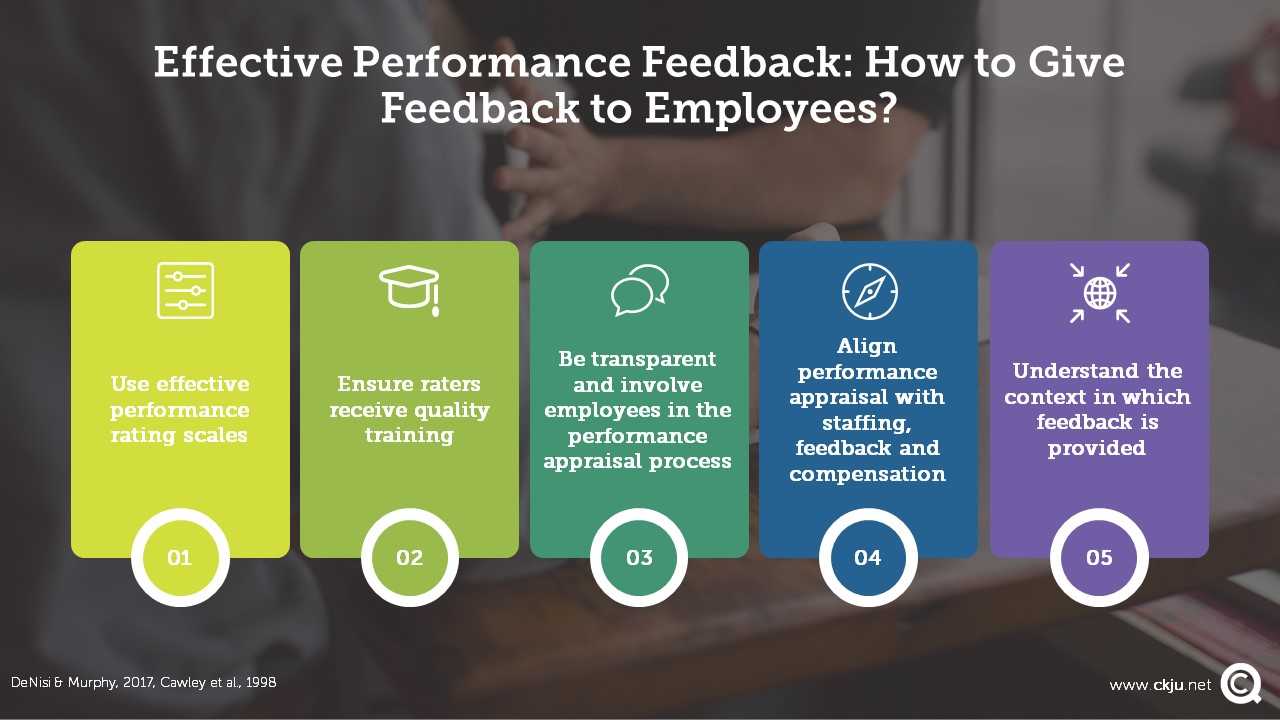- All Management Learning Resources
- How to give performance feedback

Executive summary
This CQ Dossier focuses on effective performance feedback and how to give performance feedback to employees that improves individual and organizational effectiveness. We review recent research from psychology and related social sciences and summarize the key findings such that managers and professionals can implement them in their organization. Key findings include the need for regular feedback, transparency and employee involvement, rater training as well as the relevance of the specific context feedback is given.
Contents
- Executive summary
- Create an effective performance feedback system
- Provide effective feedback to employees
- Effective Feedback: Key Principles Use Effective Performance Rating scales
- Ensure Raters receive quality training
- Be Transparent and involve employees in performance appraisal process
- Align Performance Appraisal with Staffing, Feedback and Compensation
- Understand the context in which feedback is provided
- Key take-aways
- References and further reading
Create an effective performance feedback system
Providing effective performance feedback is a key human resource management strategy to enable organizations to retain and support talent management. Organizations can develop the knowledge, skills and abilities (KSAOs) of employees for successful performance through providing effective performance feedback that grows and develops employees (Boon et al., 2017).
Provide effective feedback to employees
It is important for organizations to provide feedback to employees to engage job performance and employee motivation. The feedback needs to be clear, specific and detailed so that employees gain information on their strengths and weaknesses. This knowledge allows employees to gain better knowledge of their job duties and consider how to improve and refine their performance (Humphrey et al., 2007). Feedback is important because it also helps identify gaps in current knowledge so is related to training analysis that identifies training needs and shows strengths and developmental opportunities. Organizations become successful when employees develop and grow through performance feedback and learning (London, 1997). Providing effective performance feedback, as part of an effective performance management system, also enables organizations to identify individuals for promotion and to facilitate lateral transfers through identifying current individual strengths.
Goal-setting theory demonstrates that employees respond best to feedback when they are assigned goals that are specific and difficult for task performance (Locke & Latham, 2002). It is important for management to set specific, difficult goals early in the process rather than vague goals or merely encouraging employees to do their best. Integral to the process is that employees accept the difficult goals and accept the feedback that is given by their supervisor. Feedback provides opportunities to clarify expectations and adjust goal difficulty. Management can provide opportunities for employees so they can self-monitor their progress. These progress report can be implemented throughout the year through an effective performance system that includes continuous conversations and discussions about employee progress (Pulakos et al., 2015).
Effective Feedback: Key Principles Use Effective Performance Rating scales
A recent review of performance appraisal research reveals several solid principles that can be engaged as part of a performance management system (DeNisi & Murphy, 2017). In their review of the literature, DeNisi and Murphy (2017) concur that, despite all the research, the search for a superior rating scale has not been successful. However, they also state that this surge in research demonstrated that some scales are superior to others. For example, the use of anchored performance judgments in behavioral terms has improved the clarity of performance ratings. This research shows that it is important for organizations to utilize solid and clear performance rating scales that are accepted by all employees in the organization.
Ensure Raters receive quality training
The second important principle in providing effective performance feedback is to ensure that raters receive quality training. Empirical research has sought to determine: a) how best to train raters and b) to determine the effectiveness of rater training (DeNisi & Ford, 2017). The consensus on rater training is that it is best to train raters in best practices rather than focuses on what not to do or how to avoid errors such as rater bias. The best way in which to provide training is in establishing concepts on what represents effective vs. ineffective performance. It is also important to train raters on which behaviors and competencies constitute performance.
Be Transparent and involve employees in performance appraisal process
Third, the research shows that attitudes towards performance ratings matter to the incumbent (DeNisi & Murphy, 2017). A meta-analytic review of the literature shows that participation in the appraisal process is important because it is related to employee reactions (Cawley et al., 1998). In fact, justice perceptions are an integral part of performance ratings and can be aligned with effective performance management systems (DeNisi & Murphy, 2017).
Align Performance Appraisal with Staffing, Feedback and Compensation
Research conducted on performance feedback also demonstrates that performance appraisal is an integral component of performance management; however, linking individual and firm performance has been problematic (DeNisi & Murphy, 2017). One of the best ways in which to link individual and firm performance is through acknowledgment that performance appraisal, as a human resource practice, is a component of a parcel of activities that align staffing, performance feedback, and compensation with the strategic goals of the firm (DeNisi & Murphy, 2017). In this way performance feedback would be viewed as a broader set of human resource activities. However, DeNisi and Murphy (2017) point out that many of these models need to be more thoroughly tested to assess their effectiveness.
Understand the context in which feedback is provided
One of the other features of effective performance feedback is in understanding the context in which feedback is provided (DeNisi & Murphy, 2017). Much of the research on performance feedback has considered particular aspects of the process, including cognitive processes, scales and training, without considering the situation in which the appraisal takes place. Research in organizational psychology informs us that the climate and culture within the firm shapes the beliefs concerning talent and this can impact the appraisal system (DeNisi & Murphy, 2017).
Overall, the research on performance feedback is useful in detailing how best to provide feedback to individuals. However, it is important to consider how performance feedback should be integrated into an effective performance management system for feedback to be effective (DeNisi & Murphy 2017). Advances in organizational science inform both scientists and practitioners that it is prudent to be aware of how changes in technology and organizational culture influence performance feedback.
Key take-aways
- Performance feedback needs to be clear, specific and detailed
- Assign goals that are specific and difficult for task performance
- Ensure that raters receive quality training
- Allow employees to participate in the appraisal process
- Link performance appraisal to the strategic plan
- When providing feedback be aware of the organizational culture and climate
Management skills newsletter
Join our monthly newsletter to receive management tips, tricks and insights directly into your inbox!
References and further reading
Boon, C., Eckardt, R., Lepak, D. & Boseli, P. (2017). Integrating strategic human capital and strategic human resource management. International Journal of Human Resource Management, 1, 34.
Cawley, B. D., Keeping, L. M., & Levy, P. E. (1998). Participation in the performance appraisal process and employee reactions: A meta-analytic review of field investigations. Journal of Applied Psychology, 83, 615–633.
DeNisi, A. S., & Murphy, K. R. (2017). Performance appraisal and performance management: 100 years of progress? Journal of Applied Psychology, 102(3), 421-433.
Humphrey, S. E., Nahrgang, J. D., & Morgeson, F. P. (2007). Integrating motivational, social, and contextual work design features: A meta-analytic summary and theoretical extension of the work design literature. Journal of Applied Psychology, 92, 5, 1332.
Locke, E.A., & Latham, G.P. (2002). Building a practically useful theory of goal setting and task motivation: A 35-year odyssey. American Psychologist, 57, 705–717.
London, M. (1997). Job Feedback: Giving, Seeking, And Using Feedback for Performance Improvement. Mahwah, N.J: Lawrence Erlbaum Associates.
Pulakos, E.D., Mueller-Hanson, R.A., Arad, S., & Moye, N. (2015). Performance management can be fixed: An on-the-job experiential learning approach for complex behavior change. Industrial and Organizational Psychology: Perspectives on Science and Practice.
About the Author







